Joy Neal Kidney's Blog, page 62
October 16, 2021
Leora Attends Mrs. Connrardy’s Sewing College–1910
Leora Goff, of rural Melville Township, Audubon County, Iowa, was the oldest of ten children. She wasn’t allowed to attend high school. She was needed at home to help her mother, at least until she got married and started her own home. But her father finally decided that since she still wasn’t married by the age of 19, she could go to sewing school. It would be one way she could at least make a little income for herself.
Alice Connrardy, who wore her dark hair pulled loosely back with a knot on top, ran a successful sewing school in the town of Exira, Iowa, from about 1896 until 1925. She trained at the Baughman School for Dressmaking in Chicago, then taught girls and women at her home in Exira. Mrs. Connrardy ran a well-known sewing school for several years, beginning about 1896, with students coming from “many parts of the country,” often returning for advanced work.
The Baughman Adjustable Tailor System included learning to draft patterns, in addition to using a treadle sewing machine, handwork, and choosing fabrics. Mrs. Connrardy, the wife of John B. Connrardy (a German immigrant who had served in the Civil War and been elected Audubon County Sheriff twice) returned to Chicago occasionally for a refresher course.
For a time, the sewing classes met above a local store, then later were held in the large Connrardy home at 600 Railroad Street in Exira. Students found homes for board and room during their six-week class.
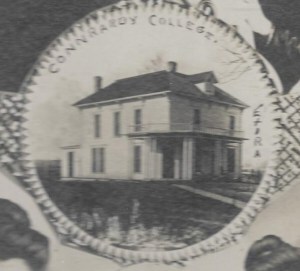
Leora Goff attended with her friend Katie Dutler during April and May, 1910. Katie’s older sister had attended the school. The girls boarded with Katie’s elderly childless German aunt and uncle Jake Engle, in exchange for help with laundry, ironing, and other chores.
Leora got quite a bit of mail while she was in Exira–at least twenty postcards from family and friends, and even a couple of boyfriends.
 Exira, Iowa, in 1909
Exira, Iowa, in 1909The girls attended a party one clear, warm evening which made it easy to see the tail of Halley’s Comet. Leora’s sister Georgia sent a newsy postcard telling about seeing the comet three times, mentioning its long tail.
The seamstresses rode the train ten miles north to Audubon for the class picture. Photographed by Harper, most of the seamstresses were pensively leaning on their hands.
A newspaper clipping from The Audubon County Journal, May 26, 1910, noted that “Mrs. Connrardy, her assistant and sixteen pupils in dressmaking went to Audubon Friday and had class pictures taken which they will highly prize as the years ago by.”
 Katie Dutler is in the top left. Second row at right is Mrs. Connrardy. Middle: Connrardy College, Leora Goff at right. Next row, middle: Marie___, then the assistant. Bottom row: last two are Edith Christensen and Clara Lund. Taken May 20, 1910, Audubon, Iowa.
Katie Dutler is in the top left. Second row at right is Mrs. Connrardy. Middle: Connrardy College, Leora Goff at right. Next row, middle: Marie___, then the assistant. Bottom row: last two are Edith Christensen and Clara Lund. Taken May 20, 1910, Audubon, Iowa. Class of 1907: Back: Bertha Baker, Carrie Boehme, Julia Jensen, Anna VandeBrake. Center: Ella Brady, Alice Connrardy, Viola Christensen, Hannah Lane. Front: Matilda Steffensen, Doris Johnson.
Class of 1907: Back: Bertha Baker, Carrie Boehme, Julia Jensen, Anna VandeBrake. Center: Ella Brady, Alice Connrardy, Viola Christensen, Hannah Lane. Front: Matilda Steffensen, Doris Johnson.When Leora wasn’t needed at home for feeding threshers or popcorn harvesters, she sewed for people in the area, sometimes staying with the family while she worked.
Wichita, Iowa
I located a clipping from Guthrie Times three years later noting that “Leora Goff sewed a couple of days this week for Mrs. C. W. Powell.”
Then, the winter of 1913-14, Leora sewed her own wedding gown. She married Clabe Wilson in February of 1914. Leora did indeed highly prize that 1910 dressmaking class picture, which followed her from home to home as she raised her family.
 Clabe Wilson and Leora Goff were married at Wichita, Guthrie County, Iowa, February 15, 1914.
Clabe Wilson and Leora Goff were married at Wichita, Guthrie County, Iowa, February 15, 1914.Dexter
Several years and seven youngsters later, the Wilson lived on a farm southeast of Dexter, Leora ordered a brand new Singer treadle sewing machine through the Sears, Roebuck catalog. The mailman left a note that a package had arrived at the post office that was too big to come on the route. Leora’s young sons rode Nancy the horse to school, two miles away, so she had to wait for the boys to get home. She hitched up Nancy to a buggy, then drove into town to pick up her treasure.
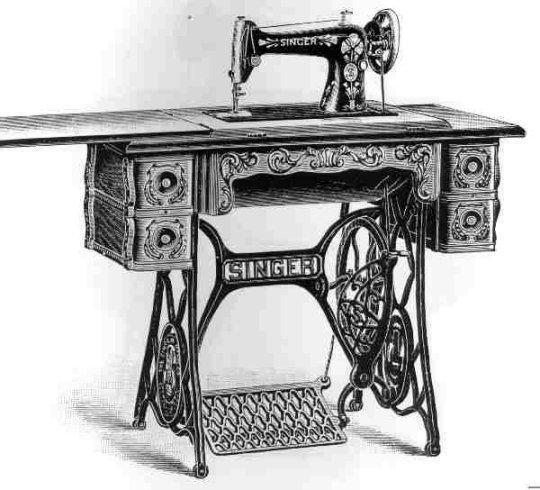
Her sewing machine was powered by rocking the treadle back and forth with her feet. Leora made Doris a light green pongee Easter dress that year. She also sewed dotted swiss dresses for both daughters–blue for Doris, red for Darlene–which they wore to Dexfield Park one Sunday, where people remarked about those dotted swiss dresses.
 Doris Wilson, Easter 1925, in her green pongee dress made by her mother.
Doris Wilson, Easter 1925, in her green pongee dress made by her mother.The sewing machine case had three drawers on each side. After Wilsons moved into town, Clabe came home one day with a couple of orphaned baby squirrels. Only one lived, Rusty. He would scamper up their arms, and also climb up into the sewing machine where he would hide walnuts and other things up in the drawers.
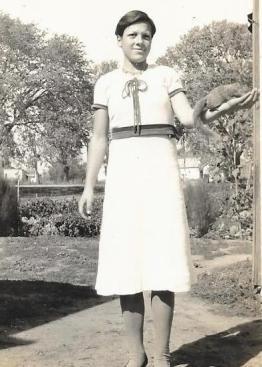 Darlene Wilson with Rusty the squirrel
Darlene Wilson with Rusty the squirrelLeora’s wedding gown did not survive the Great Depression, the fabric being used up for items they needed more. After the World War II and losing so many members of her family, she moved to Guthrie Center where she made a home for years for her own mother.
Guthrie Center
Both women were members of the Rebekah Lodge there. Every other Thursday afternoon, a group of them would gather at the Guthrie County Hospital to “offer their services as seamstresses, making new articles and mending the old.” Leora Wilson worked with that group for decades. She was the one who knew how to use the old treadle machine.


In her hand-written memoirs, Leora wrote that she’d been patching at the hospital since 1957–over 600 times. When she 92 years old, she was chairman of the Rebekah’s mending committee.
No, the wedding gown didn’t survive, nor the green pongee or the dotted swiss dresses, not even the treadle sewing machine. But that picture of Mrs. Connrardy’s spring 1910 sewing class is still highly prized, by Leora’s oldest granddaughter.
 The 1910 class picture in a chair from Leora Wilson’s home with an antimacasser on the back that she crocheted.
The 1910 class picture in a chair from Leora Wilson’s home with an antimacasser on the back that she crocheted. Susie Simpson, a great granddaughter of Alice B. Connrardy, shared a picture of the “sewing school house” as it looks today.
Susie Simpson, a great granddaughter of Alice B. Connrardy, shared a picture of the “sewing school house” as it looks today.Leora Goff Wilson was the mother of the Wilson brothers featured on the Dallas County Freedom Rock at Minburn, Iowa. All five served. Only two came home. Their story is told in Leora’s Letters: The Story of Love and Loss for an Iowa Family During World War II.
Also Leora’s Dexter Stories: The Scarcity Years of the Great Depression.
Click to share on Twitter (Opens in new window)Click to share on Facebook (Opens in new window)Click to share on LinkedIn (Opens in new window)MoreOctober 14, 2021
Stonehenge – Twice
Two outvoted three – 1988
The summer son Dan was thirteen, we visited his aunt and uncle (Lois and David) in Kings Lynn, England, which included being tourists. Dan wanted to see a Dr. Who display in London, eat at their Hard Rock Cafe, and see Stonehenge.
Lois and David told Guy that Stonehenge was just a bunch of rocks. Lois’s brother, who I was married to, agreed with them. When I broke the news to Dan that we might have to skip Stonehenge, he asked why we’d go all that way and not get to experience it. I was on his side.
Somehow we outvoted the other three.
 I have no idea why we didn’t get better photos, at least a group one. The top one is Dan, me, and brother-in-law David Kail. Dan, age 13, is in the bottom one.
I have no idea why we didn’t get better photos, at least a group one. The top one is Dan, me, and brother-in-law David Kail. Dan, age 13, is in the bottom one.June 17, 1988, “We got caught in traffic on the London orbital, but finally got around it. We zipped over a hill and there it was on the top of the next – much more impressive than we feared. . . . Two jackdaws were nesting there.”
Arriving from the east, our view was spectacular, with the historic grey stones arranged in the distance on a flat plain, with a sprinkling of white sheep in the foreground.
In spite of being patrolled by helicopter, there is a certain ambiance to the place. Even the three naysayers would agree.
It was a humid day. Before leaving we ate ice cream in the shade of a hawthorn bush and talked to a taxi driver. “W’ll, now that you’ve seen Stonehenge, can ya die happy now?” I had to laugh, but answered yes! At least Dan could cross off one thing on his bucket list, and so could his mom.
Doris and Darlene – 1997
Mom and Aunt Darlene were the first in the family to see where their younger brother, Danny Wilson, is buried in an overseas cemetery in eastern France. Guy and I were their backup crew, October 1997. Our travel agent asked the sisters, farm women who were in their late 70s, what else they’d like to see, since this would probably be their only overseas trip.
Notre Dame, the Eiffel Tower, Versailles, Normandy were on the list. What about London? Sure–Tower of London, Westminster Abbey for a service, a ride on the Thames. Mom wanted to see Bath, and added that since her grandson had seen Stonehenge, she didn’t want to miss it.
 October 14, 1997
October 14, 1997Stonehenge didn’t disappoint this time either. We all framed this photo when we got home, to remind us of the entire incredible trip.
Doris and Darlene’s 1997 journey to France.
October 13, 2021
Darcy Dougherty Maulsby, Iowa’s Storyteller, Endorser of “Leora’s Dexter Stories”

“Joy never forgets that the biggest part of history is ‘story.’ She has a gift for transforming the facts of one Iowa farm family’s struggles, joys and tremendous sacrifices during the Great Depression and World War 2 into significant stories of grit, resourcefulness and power of the human spirit. We live in a world shaped by the World War 2 generation’s courage, personal responsibility, humility, work ethic, commitment, integrity and service to others.
“If you wish to make a positive impact with your own life, there’s no better place to find inspiration than in the lives of the Wilson family.”
Darcy Dougherty Maulsby is Iowa’s Storyteller and part of family that operates a Century Farm in Calhoun County near Lake City and Yetter. She also runs her own marketing/communications company, and is the author of several books, including A Culinary History of Iowa, and Dallas County.
Darcy’s website. Her Amazon Author Page.

October 11, 2021
Famous Hog Raiser: Daniel Ross Wilson
Grandma Leora Wilson wrote in her memoir that her husband Clabe and his father, Daniel Wilson, were in the purebred hog business, and had won prizes for them at the Iowa State Fair.
But when she claimed that one male hog brought over $2000, “a fortune in those days,” I was skeptical. Until I found the 1907 clipping.
 Panora Vedette, October 3, 1907
Panora Vedette, October 3, 1907Clabe, then 19 years old, was Dan Wilson’s only son. Dan had taught him to hunt and trap, to ride and take care of horses, to identify the flora and fauna of the woods in Iowa’s Guthrie and Dallas Counties. He even let Clabe keep a young wolf as a pet when he was a boy.
And they raised hogs. They’d owned LaFollett #36563 about a year, so in 1907 there were several of his offspring ready to sell. They decided to sell #36563, too. Just like fancy horses, these red hogs with droopy ears were known by their pedigrees.
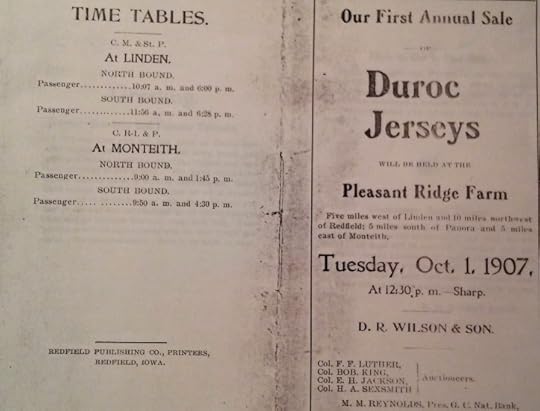

This hog was so famous that you can now even google LaFollette 36563 and find him!
Because of Dan’s asthma, according to a Panora Vedette item that fall, they planned to sell out and try another climate, maybe the Ozarks. But by the next January, he had attended a hog sale at Yale, Iowa, and had invested in “new blood.”
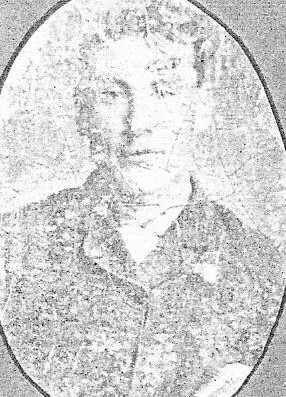
Even though they showed three Duroc Jerseys at the 1908 Iowa State Fair, Dan Wilson’s health was deteriorating: July–attack of apoplexy (stroke), October–stroke, January 1909–stroke of paralysis. In February he threw a corn knife at his son, according to records from Clarinda State Hospital, where he was admitted in March.
Dan Wilson had been a “periodical drinker to excess” and “domestic relations have never been pleasant.” Now after the strokes, he could barely use his left arm. Evidently right handed, he sent a photo postcard of himself, with such a poignant note to his wife, “I am anxious to hear from you all love to you all from your best friend.”


died in the state hospital that April, leaving a widow (Georgia), son Clabe, two adult daughters, two small daughters (ages six and two), and a barnyard of red hogs.
October 8, 2021
The 50 State Freedom Rock Tour
Iowa has 99 counties. Freedom Rock founder and artist Ray “Bubba” Sorensen just completed the 99th Freedom Rock this fall. He calls his project “a unique 99 piece mural across Iowa,” and indeed it’s an iconic legacy for the entire state.
Iowa’s Freedom Rock #100 will be auctioned for a veterans’ charity.
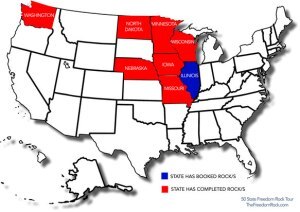
Meanwhile, the 50 State Freedom Rock Tour is underway, spreading the message of gratitude for veterans beyond his home state of Iowa. Five are already completed, with two more booked. Click the link to see if your state has a Freedom Rock in the works.
Each year, Ray and Maria Sorensen create a calendar promoting a dozen Freedom Rocks. “Our” Dallas County Freedom Rock is the October feature for 2022! The five Wilson brothers are on one side. The north side remembers Bob Feller (from Van Meter) and Nile Kinnick (grew up in Adel).
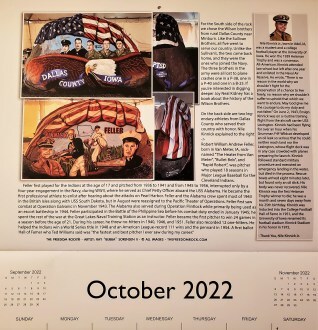
Calendars are available here.
Here’s Ray “Bubba” Sorensen’s 20-minute interview with Our American Stories.
October 6, 2021
Van Harden, Author and Broadcaster, Endorser of “Leora’s Dexter Stories”

“Many of us have had relatives that saved every little thing to the point of ridicule. When you laughingly tell people about it, the response is, ‘They lived in the depression, didn’t they?’ And yes it’s true. When I’d open a certain cupboard in my Gramma’s kitchen, there would be an avalanche of Cool Whip containers or Parkay butter tubs. Funny to us, but not to them. In this book, Joy shows us what it was really like, and in an Iowa area where I lived myself for some time. Thanks Joy for the reality check!”
Van Harden retired as our well-loved early morning broadcaster on WHO-Radio. He generously wrote the foreword for the first Leora book, Leora’s Letters: The Story of Love and Loss for an Iowa Family During World War II, and even interviewed me in the studio about it.
Van is the author of two books (so far), an inventor, and a speaker. Here’s his website.

October 4, 2021
Dexter’s 1916 Community Building AKA the “Roundhouse”
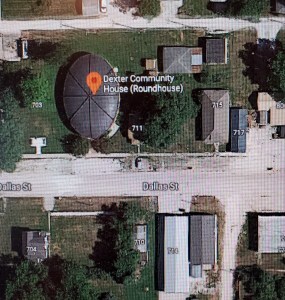
It isn’t round! Google Dexter, Iowa. Zoom in on the main street. Switch to satellite and to the NW of the downtown is the very pleasing elliptical-shaped domed roof of Dexter’s 1916 Community Building.
It was built to replace a temporary tabernacle, which had been used for revival meetings, Lyceums, high school plays, and social gatherings. Dexter was in its “heyday” in the early 1900s, so the churches and town fathers began plans for a permanent building.

They hired Matthew Leander King as the architect. Born in Panora, King studied engineering at Iowa State College (now ISU) and developed very strong hollow-core tile, which became widely used in building silos. There are no supports inside. The domed roof is supported by those innovative tiles with steel girths in the outside walls.
A stage was built on the north end, with dressing rooms and locker rooms and coal bins underneath. As you can imagine, Dexter became popular for holding basketball tournaments. And band concerts, Chautauquas, political gatherings, special church services, and box socials.
For the end of the year celebrations during the 1950s, our music teacher, Ruth Sellers, would have spring production which included the entire Dexter School. Students would line the bleachers on the east side of the auditorium, with the audience seated on chairs on the floor, with part of the floor cleared for dancers (including square dancers) and the annual May Pole Dance.
More recently, the historical building has welcomed films, plays (see photo), bus groups (including the Red Hat Ladies). I even joined a book club there this summer to talk about Leora’s Letters, since the Wilson children grew up in Dexter during the Great Depression.
 This group, Music/Theatre Artists, the anchor for Adventureland entertainment, also provided music after the park season ended for a production at the “Roundhouse” around 1980. (They eventually toured from New York City to Chicago to Colorado to Las Vegas and did a 5-week USO Caribbean Tour.) John Busbee, founder of Des Moines’ Culture Buzz, is second from left in the back. Kimberly Busbee is on the left in front.
This group, Music/Theatre Artists, the anchor for Adventureland entertainment, also provided music after the park season ended for a production at the “Roundhouse” around 1980. (They eventually toured from New York City to Chicago to Colorado to Las Vegas and did a 5-week USO Caribbean Tour.) John Busbee, founder of Des Moines’ Culture Buzz, is second from left in the back. Kimberly Busbee is on the left in front.I wonder whether the founders would be surprised to learn that wrestling matches have been held there. Pro wrestling!

The 1916 Dexter Community Building is listed with the National Register of Historic Places in Iowa.
Sources: Buildings of Iowa by Gebhard and Mansheim.
Dexter Centennial history, 1968, pages 49 and 50.
I didn’t realize until the centennial of the building that my great grandfather, O.S. Neal, had been on the committee, as a representative of the Presbyterian Church.
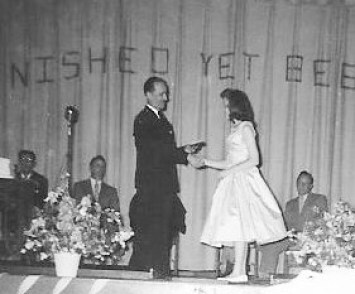 Eighth grade graduation was held there in 1958. As President of the School Board, Dr. Chapler handed out our diplomas. He came to Iowa in 1933, just in time to patch up Buck Barrow, brother of Clyde (Bonnie and Clyde infamy). He and Doctor Osborn delivered hundreds of us in the area and administered our first polio shots.
Eighth grade graduation was held there in 1958. As President of the School Board, Dr. Chapler handed out our diplomas. He came to Iowa in 1933, just in time to patch up Buck Barrow, brother of Clyde (Bonnie and Clyde infamy). He and Doctor Osborn delivered hundreds of us in the area and administered our first polio shots.
The grandson of architect Maj. King is the actor Nick Nolte.
I hesitate to call the Dexter Community Building “the Roundhouse” because a roundhouse is a railroad term. Since Dexter is on the Rock Island Railroad, people take it for granted that their roundhouse is for housing and repairing locomotives.
Most of the community events–concerts, basketball games and tournaments, dances, political talks, and graduations–mentioned in Dexter in Leora’s Dexter Stories: The Scarcity Years of the Great Depression–were held in this handsome building.
September 29, 2021
Permission to Publish a Depression Era Newspaper Photo
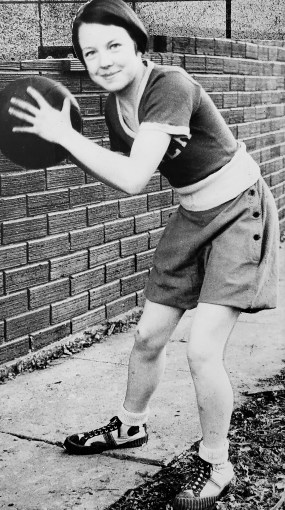 ©USA TODAY NETWORK
©USA TODAY NETWORKThis photo was published in The Des Moines Tribune, Sports section, January 10, 1933.
“Dexter High Girls Seek First Cage Victory of Season. Although beaten in every game so far this season, Dexter has a scrappy team which has displayed good teamwork, but they are handicapped because of size. Verna Maulsby and Doris Wilson will start as forwards, Ethel Schoonover and Mildred McMullen at centers, and I. G. Hoy and Mary McMenamin at the guard. Wilson, although a freshman, is showing promise and is expected to develop into a fine forward.”
I wanted to use this photo of mother in Leora’s Dexter Stories: The Scarcity Years of the Great Depression, so I went through the red tape to obtain permission. The Des Moines Tribune is no longer published but was owned by The Des Moines Register. In 1985, the newspaper was sold to Gannett. They directed me to use the copyright ©USA TODAY NETWORK with the photo every time I publish the photo.
And as long as I don’t sell more than 1000 copies of the book, the charge to reprint the 1933 photo was $150.
I dearly wanted to publish the photo of this left-handed girl in the too-big shoes and baggy socks, with a rough and tumble scab or two from shooting baskets with her older brothers, at the time playing old-fashioned three-court girls’ basketball.
I paid the $150.
Doris’s basketball story.
September 28, 2021
Ahhhhhhhhhh Choo! Bless You! – Guest Blogger, Paul Kotz
Dr. Kotz is a lifelong learner with education and business expertise. This includes working as faculty and advisor with undergraduate, graduate students and since 2013, in a doctoral program in leadership. Kotz has taught and served as an executive coach to graduate students and business professionals; and has assisted high school students in navigating adolescence.

In 2020, he published Profiles in Kindness – an award winning CIPA/Reader’s Choice Award for motivation & inspirational leadership. In 2018, he released the CIPA Award winning Something Happened Today, addressing seeing the goodness in everyday life even in the face of adversity. In 2014, he published Personality, Gender and Learning Styles for students and practitioners. His new book, Start Late – Finish Happy – will be released in late 2021. Dr. Kotz is a resident of Saint Paul, Minnesota and continues to collect new experiences that shape and challenge his perspectives.
Yes, Paul is in academia, but he’s so relatable and approachable. His gentle common-human-foibles stories are delightful. They made me rethink my knee-jerk reactions to circumstances.
Because of Jerry O’Brien‘s similar interaction with a respected teacher, I believe the student in Paul Kotz’s story will carry this prophetic scene the rest of his life.
Paul is a regular contributor to Our American Stories. His Amazon Author Page
September 27, 2021
Leora’s Mother: Laura (Jordan) Goff (1868-1962)
Firstborn.
The next three children are buried at Monteith. Laura’s small siblings didn’t live past age 5.
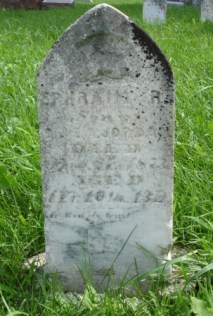
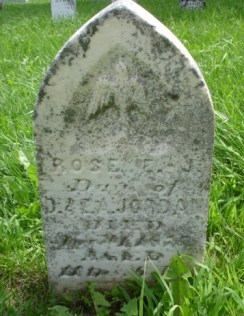

Ephraim Riley Jordan died in 1873, almost 2 year old. Rose Emma Jane Jordan died in April 1875 of “brain fever–almost a year old. Phoebe Caroline “Cally” died the next month, age 5.
 Laura Jordan at ages 6 and 13.
Laura Jordan at ages 6 and 13.Both parents had come to Iowa from eastern states. Her mother Emilia Ann (Moore) Jordan, as a nine-year-old, rumbled across the prairie in 1855 with her family (Ephraim W. and Lucy Jane Moore and five other children), in two wagons from Parke County, Indiana. She later met and married David Jordan, who’d arrived in Iowa from Noble County, Ohio, as a young man with his father in 1865.
 David and Emilia Jordan Family, late 1889 or early 1890. L-R: Floyd Roy (b. 1880), Emilia Ann (Moore) Jordan (1846), Frederick David (1889), Floy Temperance (1876), Lottie Belle (1878), Collis Moore (1883), Laura Arminta (1868), Cora Nell (1886), David Jordan (1842).
David and Emilia Jordan Family, late 1889 or early 1890. L-R: Floyd Roy (b. 1880), Emilia Ann (Moore) Jordan (1846), Frederick David (1889), Floy Temperance (1876), Lottie Belle (1878), Collis Moore (1883), Laura Arminta (1868), Cora Nell (1886), David Jordan (1842).Laura taught country school before marrying Sherd (Milton Sheridan) Goff–whose parents paid a fee so he wouldn’t have to serve in the Civil War. Laura sold her teacher’s watch to her father for a cow when she was required to quit teaching to marry.
Sherd and Laura moved over a dozen times, giving birth to eleven children, from Guthrie County to NE Nebraska (where Santee Sioux were neighbors), Guthrie County again, then NW Minnesota, and back to Guthrie County. Sherd “went bust” in Nebraska, and probably more times than that.
The Goffs finally settled for five years in Audubon County, where they made enough raising popcorn to buy a farm at Wichita, Iowa.
 July 4, 1907, Audubon, Iowa. The only family portrait of all of the M.S. Goff family. Back: Jennings (11), Georgia (13), Merl (15), Leora (16), Wayne (14), Rolla (almost 9). Front: Ruby (almost 7), Milton Sheridan “Sherd,” Perry (almost 4), Clarence (almost 2), Laura (pregnant with Virgil), Willis (5).
July 4, 1907, Audubon, Iowa. The only family portrait of all of the M.S. Goff family. Back: Jennings (11), Georgia (13), Merl (15), Leora (16), Wayne (14), Rolla (almost 9). Front: Ruby (almost 7), Milton Sheridan “Sherd,” Perry (almost 4), Clarence (almost 2), Laura (pregnant with Virgil), Willis (5).About the time their oldest sons were drafted for the World War, they moved to a furnished Victorian house in Guthrie Center. Laura went to a WCTU meeting at a church there in 1920 to learn how to vote.
They were a musical family, and Laura took singing lessons. (My mother remembered her lovely alto voice.) Their daughter Georgia, age 28, died while they lived there. Goffs eventually moved to Dexter to be near their oldest daughter, Leora (Goff) Wilson, and her growing family. Laura was widowed there when Sherd died in 1930.
When the Dexter house went into bankruptcy, Laura moved to Omaha to live with her son C. Z. (Clarence Zenas) who had a heating and cooling business. After her oldest daughter was widowed in 1946, they decided to move back to their Guthrie County roots.
 Laura Arminta (Jordan) Goff, photo taken by her grandson, photographer Merrill J. Goff, in Omaha, 1948
Laura Arminta (Jordan) Goff, photo taken by her grandson, photographer Merrill J. Goff, in Omaha, 1948Great Grandmother Goff was 76 years old when I was born. On the back of the picture taken of the four generations, it was noted that we were all the oldest daughters in our families.
 Baby Joy, Doris (Wilson) Neal, Leora (Goff) Wilson, Laura (Jordan) Goff. Near Minburn, Iowa, July 4, 1944.
Baby Joy, Doris (Wilson) Neal, Leora (Goff) Wilson, Laura (Jordan) Goff. Near Minburn, Iowa, July 4, 1944.I loved visiting Grandma Leora and her mother, Laura Goff, at their little home on North 4th Street in Guthrie Center, playing Canasta and Samba with them, going downtown for a “sodie,” as Great Grandmother called them.
The two of them took their very first plane ride to southern California to visit Laura’s daughter Ruby and two of her sons, Wayne and Willis.

I was a freshman in college when Great Grandmother died. I wish I’d been wiser then and asked about her growing up years. About all the moves she made. About her rich and fascinating past!



